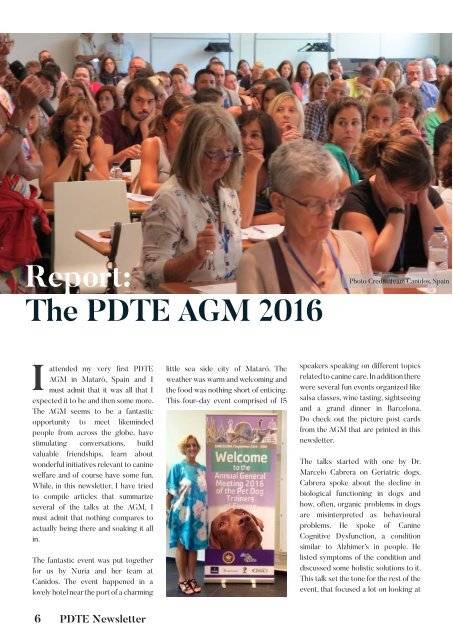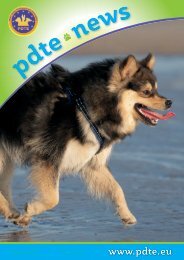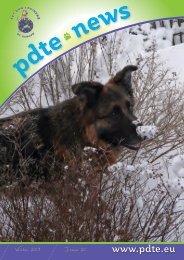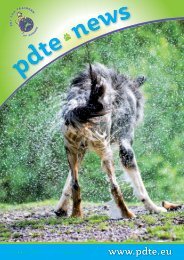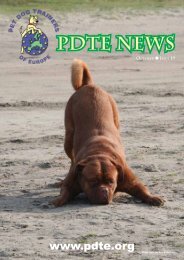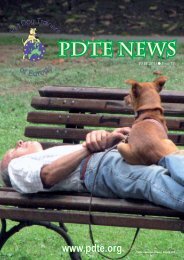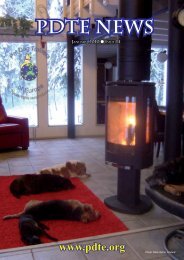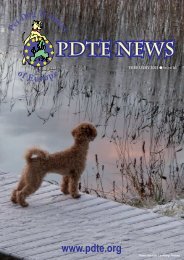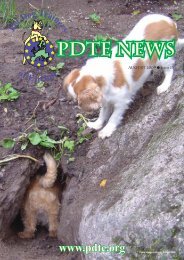PDTE 2016 December Newletter
You also want an ePaper? Increase the reach of your titles
YUMPU automatically turns print PDFs into web optimized ePapers that Google loves.
Report:<br />
The <strong>PDTE</strong> AGM <strong>2016</strong><br />
Iattended my very first <strong>PDTE</strong><br />
AGM in Mataró, Spain and I<br />
must admit that it was all that I<br />
expected it to be and then some more.<br />
The AGM seems to be a fantastic<br />
opportunity to meet likeminded<br />
people from across the globe, have<br />
stimulating conversations, build<br />
valuable friendships, learn about<br />
wonderful initiatives relevant to canine<br />
welfare and of course have some fun.<br />
While, in this newsletter, I have tried<br />
to compile articles that summarize<br />
several of the talks at the AGM, I<br />
must admit that nothing compares to<br />
actually being there and soaking it all<br />
in.<br />
The fantastic event was put together<br />
for us by Nuria and her team at<br />
Canidos. The event happened in a<br />
lovely hotel near the port of a charming<br />
little sea side city of Mataró. The<br />
weather was warm and welcoming and<br />
the food was nothing short of enticing.<br />
This four-day event comprised of 15<br />
Photo Credit: Team Canidos, Spain<br />
speakers speaking on different topics<br />
related to canine care. In addition there<br />
were several fun events organized like<br />
salsa classes, wine tasting, sightseeing<br />
and a grand dinner in Barcelona.<br />
Do check out the picture post cards<br />
from the AGM that are printed in this<br />
newsletter.<br />
The talks started with one by Dr.<br />
Marcelo Cabrera on Geriatric dogs.<br />
Cabrera spoke about the decline in<br />
biological functioning in dogs and<br />
how, often, organic problems in dogs<br />
are misinterpreted as behavioural<br />
problems. He spoke of Canine<br />
Cognitive Dysfunction, a condition<br />
similar to Alzhimer’s in people. He<br />
listed symptoms of the condition and<br />
discussed some holistic solutions to it.<br />
This talk set the tone for the rest of the<br />
event, that focused a lot on looking at<br />
underlying issues that cause so called<br />
“behavioural issues in dogs”.<br />
Julia Robertson, the founder of Galen<br />
therapy center in the United Kingdom,<br />
which specializes in providing hands<br />
on therapy for dogs that suffer<br />
from chronic pain spoke about how<br />
pain always affects behaviour. Julia<br />
repeatedly reminded us that chronic<br />
pain is insidious and invariably effects<br />
behaviour and yet is hard to spot<br />
with an untrained eye. She provided<br />
some very useful pointers on how to<br />
recognize pain and things to do to<br />
avoid pain. A synopsis of her talk is<br />
available in this newsletter, for you to<br />
get more familiar with myotherapy, its<br />
importance and its application.<br />
Julia underlined the importance<br />
of empathy, when treating pain, a<br />
concept that was echoed in several<br />
talks during the event, including the<br />
one by Pennie Clayton. Pennie spoke<br />
about Canine Bowen Therapy, a nonmanipulative<br />
technique that works<br />
on the soft tissue of dogs with very<br />
mild pressure, that does not focus<br />
on treating specific conditions, but<br />
instead focuses on reducing pain and<br />
tension throughout the whole body.<br />
The technique does not lose sight<br />
of the importance of giving the dog<br />
choices – the dog decides how long<br />
the treatment should last, when he<br />
needs breaks, if he wants to receive<br />
the treatment indoors or outdoors and<br />
if he prefers it sit, stand or lie down<br />
during the treatment. An introduction<br />
to this technique is presented in an<br />
article by Pennie in this newsletter.<br />
Winkie Spiers, the chairperson of<br />
<strong>PDTE</strong>, further elaborated on the topic<br />
of choices for a dog, in her talk titled<br />
“It’s a dog’s life”. Winkie reminded us<br />
of the basic needs of all dogs, including<br />
quality sleep, good food, clean water,<br />
freedom to eliminate at will, social<br />
contact and as many choices as<br />
possible – choices on the kind of food<br />
a dog would like and where he would<br />
like to sleep. She reminded us of how<br />
scavenging, chewing, licking etc…were<br />
natural and valuable to a dog. Her talk<br />
drove home the point that a dog lives<br />
a dog’s life and needs a dog-friendly<br />
world to live it in, which provides well<br />
for the physical and mental wellbeing<br />
of a dog. She also presented some<br />
very interesting charts on what kinds<br />
of problems clients really seek help<br />
with. These charts are all part of her<br />
article in this newsletter and definitely<br />
worth examining for dog trainers<br />
and behaviour consultants, to better<br />
understand what it is that clients really<br />
need, to bring harmony in their “canine<br />
households”.<br />
The idea of the right environment<br />
for an animal was discussed again<br />
in the talk by Dr. Jesús Rosales-<br />
Ruiz, an Associate Professor in the<br />
Department of Behaviour Analysis<br />
at the University of North Texas.<br />
He provided a framework for<br />
understanding and approaching<br />
“behavioural issues” with an approach<br />
derived from Skinner’s functional<br />
analysis of behaviour that is based<br />
on the fundamental belief that “The<br />
organism is always right”. Dr. Ruiz<br />
argued that an animal’s behaviour and<br />
personality reflects the environmental<br />
conditions the animal lives in and<br />
urged us to create constructive<br />
environments that produce optimal<br />
interactions between people and<br />
animals. He differentiated between<br />
a constructional approach (which<br />
looks at setting up a constructive<br />
environment for the organism to<br />
offer/alter certain behaviours) and a<br />
pathological approach (which focuses<br />
on solving just the problem at hand,<br />
without considering the environment<br />
in which the behaviour is established<br />
and maintained).<br />
Virginia Millares, a professional dog<br />
trainer and kennel owner, elaborated<br />
further on this idea of setting up the<br />
right environment for dogs, specifically<br />
in the situation of meet and greet in<br />
the canine world. She spoke of a fairly<br />
elaborate protocol that would set up a<br />
dog for success. Her protocol involves<br />
a detailed interview to gather as much<br />
information about the dog as possible,<br />
carefully selecting a dog that would<br />
be right for this introduction, picking<br />
a place that is safe and insulated<br />
from loud noises or other things that<br />
could scare a dog and setting up of<br />
an enriched environment for the dogs.<br />
She then outlines the process where<br />
the dogs are introduced slowly, the<br />
people are encouraged to be relaxed<br />
and the dogs are encouraged to move<br />
about slowly (by having people walk<br />
slowly and calmly).<br />
6<br />
<strong>PDTE</strong> Newsletter <strong>PDTE</strong> Newsletter 7<br />
<strong>PDTE</strong> Newsletter Dec <strong>2016</strong>.indd 6-7<br />
22-12-<strong>2016</strong> 05:04:57 PM


